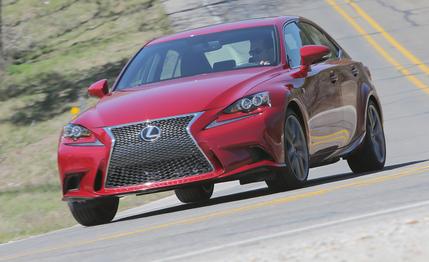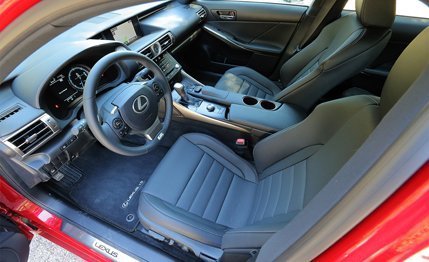
 First Drive Review
First Drive Review
If you’ve noticed there hasn’t been much to notice about the Lexus IS sedan for some time, you get an A in noticing. After debuting for the 2006 model year, the brand’s smallest rear-drive four-door went on something of a hiatus for eight seasons. (This is not including the IS F’s transcendent makeover for 2011.) Styling changes over that time were so minor that they qualified only as bar bets anywhere outside a convention of IS buffs. It’s now time, however, to reset the clock and pay attention. First shown at the 2013 Detroit auto show, there’s a brand-new IS, and we spent time shaking down the entire lineup in Austin, Texas.
The Breakdown
First things first: Lexus’s major rework of the IS does not include the engines. The 2.5- and 3.5-liter DOHC V-6s carry over, including output—no fancy, efficiency-baiting turbo four here, bub. That means the IS250 still has 204 horsepower and 185 lb-ft of torque, and the IS350 packs 306 horsepower and 277 lb-ft. You can tick off boxes for rear- or all-wheel drive and regular or F Sport trim. Most iterations use the same six-speed automatic as in the outgoing cars, but Lexus decided that rear-wheel-drive IS350s deserved the eight-speed direct-shift automatic from the IS F. (No manual this time. Lexus told us it thought it might have sold one [!] last year.) The eight-speed incorporates “G-force Artificial Intelligence” when in Sport mode, which can automatically grab a gear and go to full torque-converter lockup depending on input from a g-force sensor. All IS350s and the IS250 F Sport use an engine-sound-enhancing intake-noise generator, if you’re into that sort of thing.
All IS models have paddles for manual shifting, and their gearboxes will rev-match downshifts when in Sport mode. Sport is one of the three possibilities—Normal and Eco being the others—available via a center-console knob fitted to all examples. Rear-drive IS350 F Sports add a Sport+ level, and all-wheel-drive versions have a Snow setting. The subsystems varied with these modes are the usual, even as they vary depending on equipment and model ordered, meaning transmission shift mapping, an adaptive suspension, the electric power-steering effort, and the steering ratio. If all this sounds like a lot, it is, and even one Lexus official chuckled at the many permutations.


Lexus uses the last IS’s front suspension design but adds a larger anti-roll bar, and it adapted the multilink setup from the excellent new GS at the back. The power steering is swiped from the GS, too, and the IS’s new platform is a scaled-down version of its bigger brother’s. Braking is handled by 11.7- and 11.5-inch discs on IS250 models, and by 13.2- and 12.2-inch discs on the IS350. The rotors live behind 17- or 18-inch wheels; the larger rollers come in staggered widths and pack the most visual sizzle, and they’re standard on all F Sports.
Drive Time
When Lexus said we’d be in Austin to drive the new IS, we assumed we’d sample the sedan at the Circuit of the Americas. Not so. We instead went to Austin Driveway, a technical, vest-pocket circuit with 110-mph straights (at least in the IS350 F Sport), tight corners, and a junior version of Mazda Raceway Laguna Seca’s famed Corkscrew. Lexus brought a BMW 335i and a Mercedes-Benz C350—both with sport-suspension options—plus a last-gen IS350 F Sport for comparison. Sadly, the car with the best-handling chassis in the segment, the Cadillac ATS, was absent.